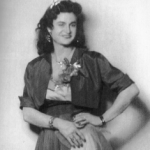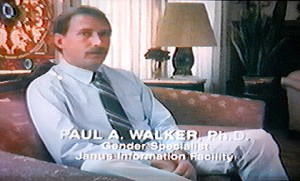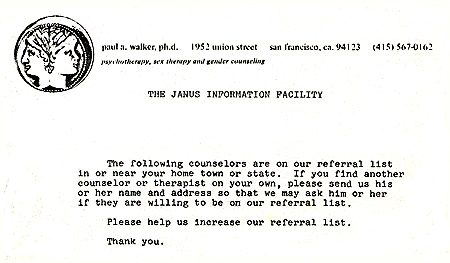Glossary
Chrysalis′ Always Growing Cumulative Glossary of All Things Trans
Harry Benjamin
 Harry Benjamin
Harry Benjamin
January 12, 1885 – August 24, 1986
Harry Benjamin was an endocrinologist and gerontologist who emigrated to the United States during the First World War. He is best known for his clinical work with transsexuals and as the author of 1966 text The Transsexual Phenomenon, which defined the clinical syndrome and argued for compassionate medical hormonal and surgical treatment in select cases.
Benjamin treated his first transsexual patient in 1948 at the request of Alfred Kinsey. He began receiving referrals from other sexologists and from the patients themselves. News of Christine Jorgensen’s sex reassignment in Denmark made headlines from 1952 on, resulting in hundreds of patients who he saw in his offices in New York and San Francisco. Benjamin published a number of journal articles and gave lectures about his patients, popularizing the word transsexual. His The Transsexual Phenomenon was the first lengthy treatise on transsexualism and was influential and highly regarded.
Benjamin lived to be 101. Virginia Prince told me on several occasions that when she asked him what he did on his 100th birthday, he told her he looked in the mirror. When she asked why, he said “I’ve always wanted to know what a one hundred-year-old man looks like!”
Reference
Benjamin, Harry. (1966). The transsexual phenomenon: A scientific report on transsexualism and sex conversion in the human male and female. New York: Julian Press. Reprinted by The Human Outreach & Achievement Institute,405 Western Avenue, Ste. 345, South Portland, ME 04106 in the 1990s.
Geoff Brown
ca 1932 – August 19, 2008
Geoff Brown was a lifelong resident of Yorkshire and the author of two novels, I Want What I Want and My Struggle. The first, published in 1966, tells the story of Roy, a young male-to-female transsexual. With no information or support, Roy changes his name to Wendy and begins living as a woman. The ambiguous conclusion suggests her early death.
I Want What I Want received good reviews, but didn’t sell well. It was, however, optioned for a motion picture. I Want What I Want… T0 Die a Woman, was released in 1972. It starred British actress Anne Heywood and was directed by John Dexter. The screenplay was written by Gillian Freeman, an author known for 1961’s The Leather Boys, an early gay-themed novel which was made into a 1964 film with the same name.
After disappointing sales of his 1975’s My Struggle, Brown put down his pen and stopped writing.
Brown’s spot-on portrayal of Wendy has resonated with many male-to-female transsexuals. For decades there was speculation about Brown. Was he transsexual? Did he transitioned? At a time when little was known about transsexualism, how did he so accurately portray a young transsexual woman? Whatever became of him?
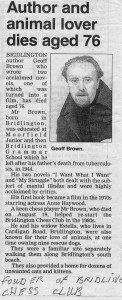 In 2007 someone took the trouble to track Brown down. Willow Arune told the story of her search for on a September 7 post in her Pangarune Corner Blog. On August 1, 2013 we reposted it here at Chrysalis Quarterly and it has subsequently appeared on the TG Forum website, where editor Angela Gardner included this obituary, which apparently ran in a Bridlington (Yorkshire, England) newspaper. Brown died on August 19, 2008, at age 76.
In 2007 someone took the trouble to track Brown down. Willow Arune told the story of her search for on a September 7 post in her Pangarune Corner Blog. On August 1, 2013 we reposted it here at Chrysalis Quarterly and it has subsequently appeared on the TG Forum website, where editor Angela Gardner included this obituary, which apparently ran in a Bridlington (Yorkshire, England) newspaper. Brown died on August 19, 2008, at age 76.
Chrysalis: The Hunt for Geoff Brown
References
Brown, Geoff. (1966). I want what I want. London. Weidenfeld & Nicolson, Ltd. Read the text here.
I Want What I Want. (1972). John Dexter, Dir. (Netherlands). See IMDB entry here.
IFGE
 International Foundation for Gender Education
International Foundation for Gender Education
IFGE was an American 501(c)(3) nonprofit educational corporation with an initial mission to “overcome the intolerance of tranvestitism and transsexualism brought about by widespread ignorance.” The organization was launched in 1987 with Merissa Sherrill Lynn as the Founding Director.
Until 2010, IFGE maintained offices in Waltham, Massachsetts. Its journal, TS-TV Tapestry (changed in the late ’90s to Transgender Tapestry) was published quarterly in perfect bound format. IFGE had an annual conference through 2010.
Executive Directors have included Merissa Sherrill Lynn, Nancy Nangeroni, Alison Laing, Nancy Cain, and Denise Leclair. Editors ofTapestry have included Lynn, Jean Marie Stine, Dallas Denny, and Denise Leclair.
Reed Erickson
October 13, 1917 – 1992
Erickson, who was born female-bodied, trained and worked as an engineer, starting a company that made bleachers for sports stadiums. When his fathered died in 1962 he inherited a majority interest in the family lead smelting businesses and ran them until 1969, when he sold his interest for $5 million. His personal fortune was soon surpassed $40 million.
In 1963 Erickson became a patient of Dr. Harry Benjamin and transitioned gender roles the same year. He turned his attention to philanthropy, funding through his Erickson Educational Foundation research on homeopathy, John Lilly’s early work on the communcation of dolphins, the dream research of Stanley Krippner, Robert Masters’ and Jean Houston’s research on altered states of consiousness, and investigations of flying saucers. EEF funded the publication of the first edition of A Course on Miracles and the first English translation on acupuncture. California’s ONE Institute was a primary recipient of EEF’s generosity and eventually became embroiled in a legal dispute with Erickson over the ownership of a building.
The Erickson Foundation funded much of the early work on transsexualism. EEF provided financial support to psychologist John Money, Richard Green, Vern Bullough, Milton Diamond, and other researchers. The EEF sponsored the first three international symposia on gender identity issues and the publication of books including Money & Richard Green’s 1969 edited text Transsexualism and Sex Reassignment.
The Erickson Foundation published pamphlets and brochures designed to educate helping professionals, the general public, and transsexuals and their loved ones themselves about transsexualism. These brochures remained in print through EEF’s successor nonprofit organizations The Janus Foundation, J2CP, and The American Educational Gender Information Service. EEF maintained a database of service providers and provided referrals and direct support to transsexuals. Zelda Supplee was the executive director of the Erickson Foundation, which was based in Baton Rouge, LA. The foundation opened in 1964 and closed its doors in 1977; this directly resulted in the formation of the Harry Benjamin International Gender Dysphoria Association (now the World Professional Association for Transgender Health. Erickson briefly revived the Foundation in 1983.
Erickson was married several times.
In his later years Erickson became a drug addict and was a fugitive from justice in the U.S. He retreated to Mexico, where he maintained a home. In the mid-1990s at the transgender event Fantasia Fair, sexologist Vern Bullough talked to me of a trip deep into Mexico by Zelda Supple and John Money, who rescued Erickson from a band of drug dealers.
The full extent of Erickson’s philanthropy and its effect on research on transsexualism might have been lost to history if not for the efforts of Canadian sociologist Aaron Devor.
References
A Course in Miracles (Link tested 11-26-2011).
A Gender Variance Who’s Who: Reed Erickson (Link tested 10-4-2011).
Devor, Aaron (as Holly Devor). (2002). Reed Erickson (1912-1992): How one transsexed man supported ONE. In Vern Bullough (Ed). Before Stonewall: Activists for Gay and Lesbian Rights in Historical Context. New York: Haworth. Online Here. (Link tested 10-4-2011)
Devor, Aaron. (2005, 27 July). Reed Erickson and the Erickson Educational Foundation. Online Here. (Link tested 10-4-2011).
Joanne Meyerowitz. (2002). How sex changed: A history of transsexuality in the United States. Cambridge, MA: Harvard University Press, pp. 210-2, 215-6, 219, 223, 258, 268, 327n5,8, 336n6. (Link tested 10/4/2011).
Vern Bullough, Personal Communication, mid-1990s at Fantasia Fair.
Miqqi Alicia Gilbert / Michael Gilbert
Miqqi Alicia Gilbert / Michael Gilbert
October 31, 1945 –
 Miqqi Alicia Gilbert, Ph.D. aka Michael A. Gilbert, Ph.D., is Professor of Philosophy at York University, Toronto, Canada. She has published two novels, a monograph entitled Coalescent Argumentation, and ll a popular book on argument, How to Win an Argument, now in a third edition. Her newest book, Arguing with People, will be published by Broadview Press in spring of 2014.
Miqqi Alicia Gilbert, Ph.D. aka Michael A. Gilbert, Ph.D., is Professor of Philosophy at York University, Toronto, Canada. She has published two novels, a monograph entitled Coalescent Argumentation, and ll a popular book on argument, How to Win an Argument, now in a third edition. Her newest book, Arguing with People, will be published by Broadview Press in spring of 2014.
Dr. Gilbert has also published scholarly articles in gender theory, including an essay in Hypatia in 2009, “Defeating Bigenderism.” A life-long cross-dresser and an activist in the transgender community, she has made a point of being out and public and has appeared in numerous newspapers and magazines in Canada and the U.S., and has been interviewed on radio and television. She has been the book review editor and regular columnist for Transgender Tapestry, was a recipient in 2007 of an IFGE Trinity Award, and has been Director of Fantasia Fair for 10 years. She has presented workshops at numerous trans events including Fantasia Fair, Southern Comfort, Esprit, IFGE, and First Event. Click here to visit Gilbert’s website.
Christine Jorgensen
30 May, 1926 – 3 May, 1989
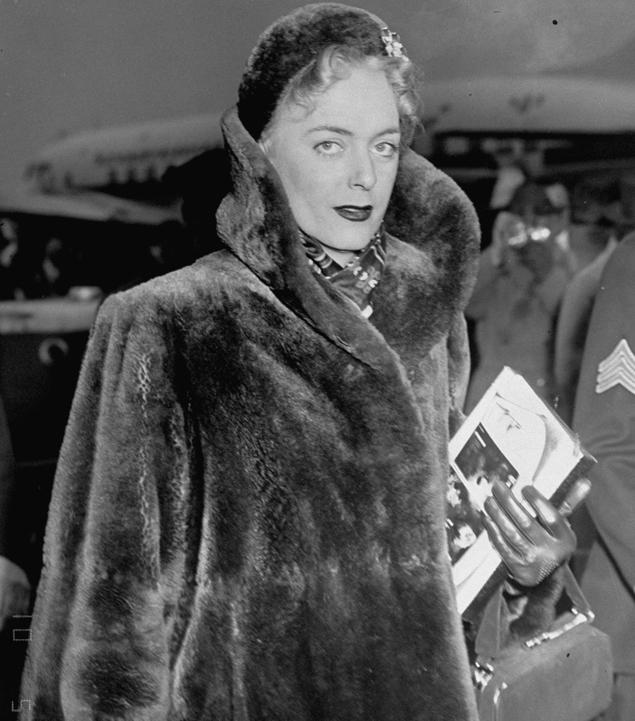 Christine Jorgensen wasn’t the first person to change sex, but she was the first to achieve celebrity for having done so. When news of her sex reassignment broke in December, 1952, the media went wild. Reporters followed her for the rest of her life.
Christine Jorgensen wasn’t the first person to change sex, but she was the first to achieve celebrity for having done so. When news of her sex reassignment broke in December, 1952, the media went wild. Reporters followed her for the rest of her life.
Jorgensen was born into a family of Scandinavian ancestry in the Bronx. Her birth name was George William Jorgensen, Jr. As a child she was introverted and avoided rough-and-tumble play. After her graduation from high school in 1945, she was drafted and served honorably as a private in the U.S. Army.
Jorgensen’s femininity persisted, and she came to speculate about the possibility of living as a woman. After she read about animal experiments in Europe with newly-synthesized human sex hormones, she began to experiment with the estrogen ethiny estradiol. On an extended trip to Scandinavia, she approached Danish endocrinologist Christian Hamburger and convinced him to provide her with hormones and surgery—castration and removal of the penis. The former, being illegal in Denmark, required permission from the government.
References
Jorgensen, Christine. ( 1967). Christine Jorgensen: A personal autobiography. New York: Paul S. Ericksson.
Christine Jorgensen Website. (Link tested 2-26-2013
Virginia Prince
23 November 1913 – 2 May, 2009
Virginia Prince was known primarily for more than one-half century of activism on behalf of heterosexual crossdressers. From age 54 she lived full-time as a woman.
Born in Los Angeles with the name Arthur Lowman, she was publicly crossdressing in her early teens. When she was 40 years old her crossdressing was exposed in an article in the Los Angeles Times. Crossdressers who read the article contacted her; this marked the beginning of what would one day be a community. [1]
In 1960 Prince launched the magazine Transvestia and distributed it to the handful of crossdressers known to one another.
In the magazine, she developed a theory of crossdressing, featured photos, personal experiences, and fiction written by her readers, and sold her books about crossdressing. She published 100 issues, ending her editorship in 1979. [2][3]
Prince began starting support groups at about the same time she launched Transvestia. including the Hose and Heels Club and The Foundation for Personality Expression. In 1976 FPE merged with Carol Beecroft’s Mamselle group to form The Society for the Second Self, which continues to provide support to heterosexual crossdressers through several dozen chapter. Offshoots of Prince’s groups continues in Europe and Australia and New Zealand.
Prince wrote or co-wrote more than a dozen articles for professional journals. Her first appeared in The American Journal of Psychotherapy in 1957. Arguably, she was the first out crossdresser to publish anything other than an autobiography in the scientific press.
Prince was a controversial figure in the transgender community. Her insistence on excluding gay and bisexual crossdressers and transsexuals from her groups and her autocratic leadership style generated resistance from the earliest days of her groups. Dissatisfied crossdressers started support groups and published magazines just to defy her. She was vehemently opposed to sex reassignment surgery and frequently demeaned transsexuals. The ultimate result of her leadership style was a fractionated community that did not come together until the late 1980s.
References
Docter, Richard F. (2004). From man to woman: The transgender journey of Virginia Prince. Docter Press.
Ekins, Richard, & King, Dave. (2006). Virginia Prince: Pioneer of transgendering. CRC Press.
Hill, Robert. (2000). “As a man, I exist. As a woman, I live”: Heterosexual crossdressing and the contours of gender and sexuality in postwar America. Doctoral Dissertation, University of Michigan. Retrieved 10 August, 2013)
Raynor, D. (1966). A year among the girls. New York: Lyle Stuart.
Virginia Prince. A Gender Variance Who’s Who. (Retrieved 10 August, 2013)
Notes
[1] In the early 1940s Prince contrived to meet transsexual Barbara Wilcox and crossdresser Louise Lawrence after they were the subjects of psychiatry presentations at a California university.
[2] An early group of which Virginia was a part published several mimeographed issues were published in 1952.
[3] Prince’s books included Understanding Crossdressing, The Transvestite and His Wife, and How to Be a Woman Though Male.
[4] See Raynor, 1966.
Linda and Cynthia Phillips
Linda Phillips (1935-)
Cynthia Phillips (1939-)
 Linda Phillips (1935-) is a life-long transgenderist. She and life-partner Cynthia Phillips (1939-) were married in 1958. In 1998 both became involved with the transgender support organization Boulton and Park Society. Both held various positions, including publishing club newsletters Gender Euphoria (1989-1999), Cross Currents (1989-1993) and Partners (1989-1993). Cynthia was a principal in Women Associated with Transgendered Support Groups in 1989 and 1990 and Women Associated with Crossdressers Communication Network.
Linda Phillips (1935-) is a life-long transgenderist. She and life-partner Cynthia Phillips (1939-) were married in 1958. In 1998 both became involved with the transgender support organization Boulton and Park Society. Both held various positions, including publishing club newsletters Gender Euphoria (1989-1999), Cross Currents (1989-1993) and Partners (1989-1993). Cynthia was a principal in Women Associated with Transgendered Support Groups in 1989 and 1990 and Women Associated with Crossdressers Communication Network.
In the 1990s, both Linda and Cynthia were members of the Board of Directors of IFGE. They were featured on many of national television shows during the 1990s, attempting to educate the general public about the lifestyle of transgendered couples, where one is an active transgender, the other not. Both held various positions of leadership in the Boulton and Park Society between 1989 and 1999.
Linda and Cynthia produced the gender event Texas “T” Party from 1990 until 1999. The Texas “T” Party was a popular event held in “the heart of Texas” for ten years and an important venue for couples. The “T” Party reached its zenith in 1998, with 100 couples taking part in the festivities and seminars.
The Linda and Cynthia Phillips Papers are archived at the University of Texas-San Antonio.
JoAnn Roberts
(1948 – 7 June, 2013
JoAnn Roberts was a transgender community activist who was most active in the 1990s. She appeared on many television shows to talk about crossdressing—but her advocacy work benefited all transpeople.
Roberts was co-founder, in 1987, of Renaissance Transgender Education Association, a consortium of support groups in the Northeast US. Her Bill of Gender Rights, published in 1990, was a watershed moment in the struggle for transgender rights.
Roberts served on the Board of Directors of The International Foundation for Gender Education several times in the 1990s and was Board Chair of the American Educational Gender Information Service from 1992 – 1996. She was a founder of both GenderPac and the National Transgender Advocacy Coalition and was a principal in the online magazine Transgender Forum (now TG Forum).
Roberts was a prolific writer. Her output included the books Coping with Crossdressing and Art and Illusion, which were distributed, along with other materials, through her company Creative Design Services. Her often acerbic essays appeared for years in Renaissance’s newsletters and magazines.
For more than a decade she ran a weekend retreat for transgendered people in the Pocono Mountains of Northeastern Pennsylvania.
Roberts died in mid-2013 of aggressive lung and liver cancer.
References
Dallas Denny. (2013, 8 June). Remembering JoAnn Roberts. Chrysalis Quarterly. Read it here.
Angela Gardner. (2013, 10 June). TGF Founder JoAnn Roberts has passed away. TG Forum. Read it here.
Monica Roberts. (2013, 10 June). Trans pioneer JoAnn Roberts dies. TransGriot. Read it here.
WPATH Standards of Care
WPATH Standards of Care
 The Standards of Care are an important tool used by clinicians and transsexual and other transgendered people to establish a demonstrated route to sex reassignment. The first version of the Standards was published in 1979 by the newly-formed Harry Benjamin International Gender Dysphoria Association. The text easily fit on the front and back of a single sheet of paper.
The Standards of Care are an important tool used by clinicians and transsexual and other transgendered people to establish a demonstrated route to sex reassignment. The first version of the Standards was published in 1979 by the newly-formed Harry Benjamin International Gender Dysphoria Association. The text easily fit on the front and back of a single sheet of paper.
The Standards were revised in 1980, 1981, 1990, 1998, and 2001. The seventh version, which was issued under the new name World Professional Association for Transgender Health, was released in September 2011 and is 120 pages long.
All versions of The Standards of Care have been produced by committees of the international association of researchers and clinicians who work with transsexual and transgendered people. The organization, formed in 1979, was originally known as the Harry Benjamin International Gender Dysphoria Association; the name honors endocrinologist Harry Benjamin, a pioneer in work with transsexualism.
In 2005 the name of the association was changed to The World Professional Association for Transgender Health.
The first six versions of Standards spelled out a recommended process for access to hormonal therapy and genital surgery, requiring letters of authorization from one therapist before starting hormones and two letters authorizing genital surgery. In Version 6 the hormone letter was issued only after three months of psychotherapy or three months of real-life experience. A prerequisite for the surgery letters was the real-life experience—a minimum of one year spent living and working (or going to school) in the target gender.
Version 7’s title reflects the changing sensibilities of WPATH and its members. Its name is Standards of Care for the Health of Transsexual, Transgender, and Gender Nonconforming People. By way of comparison, the title of Version 6 was Standards of Care for Gender Identity Disorders.
My first reading of the newly-released Version 7 finds significant change in these processes. Authorization now follows an informed consent model. It’s no longer necessary to have psychotherapy or real life experience before a referral letter can be written. Male-to-female transsexuals no are no longer required to be on hormones before breast augmentation. Genital surgery still requires a minimum of twelve months of real-life experience. Two referral letters are required.
Much has been written pro and con the Standards of Care. My opinion is this: they provide a much-needed safeguard that protects transsexuals and have saved a great deal of human misery. At the same time, I believe restricting access of a single class of people to treatment that is freely available to others can ethically be done only on the basis of empirical data—in other words, WPATH is now more than 30 years old. Where are the studies that justify the gatekeeping?
I was asking this question twenty years ago and am still asking it.
Downloads
HBIGDA SOC V 4 1990 HBIGDA SOC V 5, 1998 HBIGDA SOC V 6, 2001
Hyperlinks
WPATH SOC, V 7, 2011 WPATHSandy Stone
 Alluquere Rosanne (Sandy) Stone
Alluquere Rosanne (Sandy) Stone
1936-
Sandy Stone is a media theorist, writer, and recording engineer who is Associate Professor and Founding Director of the Advanced Communication Technologies Laboratory (ACTLab) and the New Media Initiative in the Department of Radio-Film-TV at The University of Texas at Austin. Her other affiliations include Sesnior Artist at the Banff Center, Wolfgang Kohler Professor of Media and Performance at The European Graduate School, and Humanities Research Institute Fellow at The University of California at Irvine.
In the 1970s Stone was a member of the Olivia Records Collective, where she engineered recordings for the label. When she came under attack from Janice G. Raymond the Olivia women defended her in print, but Stone left when the Collective came under threat of a boycott in 1979.
Stone’s 1978 essay The Empire Strikes Back: A Post-Transsexual Manifesto is considered by many to be the opening shot in what is now called transgender studies. Susan Stryker and Stephen Whittle cite it as such in their Transgender Studies Reader.
References
Stone, A.R. (As Sandy Stone). (1991). The empire strikes back: A posttranssexual manifesto. In J. Epstein & K. Straub (Eds.), Body guards: The cultural politics of gender ambiguity, pp. 280-304. New York: Routledge.
Stryker, S., & Whittle, S. (2006). The transgender studies reader, 221. Routledge.
Sandy Stone’s WebsitePaul A. Walker
Paul A. Walker
1946 – ?
Paul Walker was a social psychologist known for his work with transsexual people. He worked for a time with psychologist John Money the Psychohormonal Research Unit at Johns Hopkins University and later started a program for sex offenders at the University of Texas Medical Branch in Galveston.
Walker was the founding president of the Harry Benjamin International Gender Dysphoria Association and Chair of the committee which produced the first Standards of Care. I was told, I believe by Alice Webb, that Walker produced the first draft almost entirely by himself.
In Galveston Walker ran the Janus Information Facility, which continued the work of the recently closed Erickson Educational Foundation. The Facility provided information on transsexualism and referrals and reproduced the EEF’s booklets. I was in contact with Janus in the late 1970s or early 1980s and received pamphlets and a letter from Walker.
Despite Walker’s important work with transsexuals, little biographical information is available for him. The only image of him I’ve ever seen, reproduced above, is from the 1985 film What Sex Am I? In the early 1990s I was told Walker moved to San Francisco in the 1980s and had died there. I’ve left a question mark on the life span line because his history after Galveston is unclear.
Reference
What Sex Am I? (1985). Lee Grant, Dir. HBO. See a review HERE. (Link tested 10/4/2011).
WPATH
World Professional Association for Transgender Health
1979-Present
WPATH (formerly The Harry Benjamin International Gender Dysphoria Association) was formed in the late 1970s by professionals working with transsexuals. In 1979 the new organization published a two-page-long Standards of Care for the Hormonal and Surgical Sex Reassignment of Gender Dysphoric Persons. Paul Walker was Chair of the first Standards committee. Now in its 7th iteration and with as many words as a novel, the Standards are consensual guidelines developed by the organization to safeguard transsexual (and since Version 6) nontranssexual gender-variant people as they seek and use medical technologies to change their bodies.
In 1998 the organization launched the peer-reviewed International Journal of Transgenderism. The title was selected to emphasize HBIGDA’s expanding mission; its guidelines would apply not only to transsexuals, but all gender-variant people. The change of name, finalized in 2009, reflected this change of direction, and was not without conflict. Psychiarist Richard Green threatened to sue the organization. That was, I expect, mostly about the dropping of Harry Benjamin’s name. HBIGDA was named in his honor.
WPATH has done much to change the way transsexual and transgendered people are viewed by society; this by changes in the Standards of Care and the publication of cutting edge papers in its journal.



